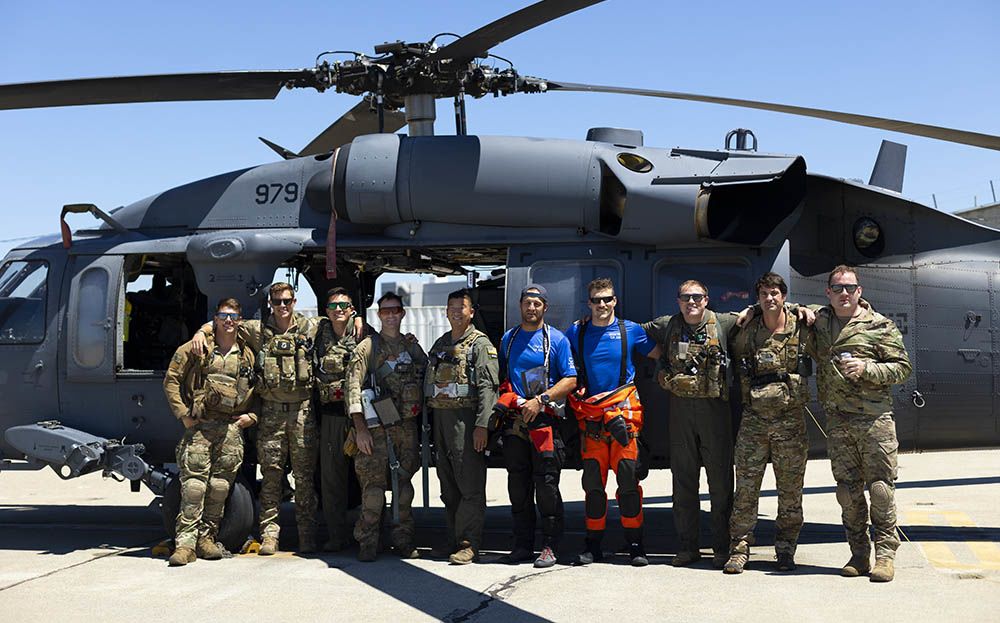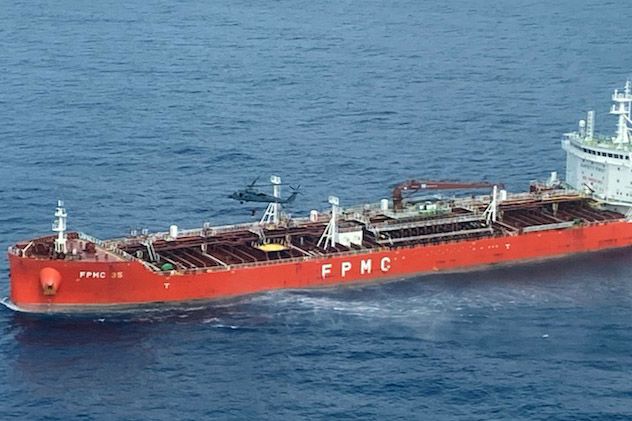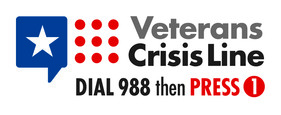
Airmen from the 129th and 131st Rescue Squadrons stand for a group photo at Moffett Air National Guard Base after successfully rescuing an injured man off a ship in the Pacific Ocean, Aug. 7. (U.S. Air National Guard photo by Staff Sgt. Crystal Housman)
MOUNTAIN VIEW, Calif. – The crew member of a racing yacht who developed a life-threatening infection at sea while returning a racing sailboat from Hawaii to California is safe on land after being stabilized and airlifted for additional medical care last week. Airmen from the California Air National Guard’s 129th Rescue Wing at Moffett Air National Guard Base hoisted the crew member from a tanker ship.
According to organizers of the Pacific Cup race, the 57-year-old Bay Area skipper of the Spindrift V was injured in heavy weather that also damaged the sails on the 37 ft. fiberglass keelboat and knocked out its communications systems.
The sailboat and its crew were more than 1,000 nautical miles from California on their way home from Kaneohe Bay, Hawaii, after placing first in their class of the Cup when race organizers alerted the U.S. Coast Guard of the skipper’s condition.
In the overnight hours of Aug. 5, he was transferred onto a Panama-bound Liberian tanker ship which diverted to provide the skipper with more medical capabilities and improved communications.
Race organizers said medical consultants from George Washington University determined the necessity of a medical evacuation for the injured man.
The injury developed into a worsening bacterial skin condition with potential for spread and serious health effects if the man stayed at sea any longer without medical attention.
U.S. Coast Guard’s 11th District, lead agency on shipboard emergency responses for California, Arizona, Nevada and Utah, officially requested pararescue response through the Air Force Rescue Coordination Center after the patient’s condition worsened.
The morning of Aug. 5, the wing launched an HC-130J Combat King II multipurpose cargo aircraft from the 130th Rescue Squadron for 10.5 hour flight along with a Guardian Angel pararescue team from the 131st Rescue Squadron.

A helicopter from the 129th Rescue Wing hoists a man from a tanker ship 343 nautical miles west of San Francisco, Aug. 7. (Courtesy photo)
Two pararescuemen jumped out of the aircraft into the ocean where they were met by the ship’s recovery boat.
Rough seas made reaching the ship from its smaller boat a challenge, said U.S. Air Force Senior Airman Bryan, one of the pararescuemen.
“Traditionally we have at least four guys on this,” he said. “Due to the waves and the ship’s recovery boat breaking down, we were only able to jump two guys.”
The boat struggled between jumps, leaving the Airmen to board the ship as a pair instead of a team of four, as originally planned.
“It was difficult to connect the ship’s hoist to the tiny recovery boat they had due to the 10 ft. waves and weak engine,” Bryan said. “The hoist was sketchy because we loaded the boat to the max.”
Bryan and his teammate held tightly to the boat as it waffled on the hoist. The weight of the boat’s crew and the pararescue jumpers tested the system’s limits.
“As it was getting raised the nose of the boat started to point down towards the water 40 ft. below us,” he said.
Once aboard the tanker, the Airmen worked in shifts to stabilize the man’s injuries by providing around-the-clock medical care including antibiotics, pain management and wound treatment.
As emergency medical treatment continued on the ship at sea, members of the 129th Operations Group at Moffett coordinated and planned a hoist rescue and airlift for the patient.
To backfill an aircraft shortage due to deployment, the group called in an HC-130 and crew from the U.S. Air Force’s 79th Rescue Squadron, an active duty unit stationed at Davis-Monthan Air Force Base near Tucson, Arizona.
Airmen from the 129th Aircraft Maintenance Squadron worked throughout the day Saturday to wash Friday’s salt water off the HC-130J and reconfigure it for the next phase of the mission. They also conducted checks and maintenance on three helicopters pegged to be the primary and backup aircraft for the rescue.
Crew chiefs in a variety of military pay statuses arrived at 5 a.m. Sunday to further prepare the aircraft. The mission, which happened during the wing’s drill weekend, had additional staffing from both full-time Guard Airmen and traditional Airmen who train on the base one weekend a month as part of a scheduled unit training assembly (UTA).
“The nice thing about it was the timing,” said Senior Master Sgt. Daniel Starner, production superintendent of the 129th Aircraft Maintenance Squadron. “It just happened to be UTA weekend, so we had more people than we normally would have.”
Two HH-60G Pave Hawk helicopters from the wing’s 129th Rescue Squadron took off from Moffett Federal Airfield at 7:40 a.m. and met the ship 343 nautical miles west of San Francisco, significantly closer and safer than the yacht’s original position of 800 nautical miles out to sea when the Coast Guard first learned of the injury.
The Arizona-based HC-130 provided the helicopters with air-to-air refueling and provided overwatch on the airlift once all three aircraft reached the ship more than two hours later.
One helicopter hovered over the ship and lowered a 40 ft. hoist to pick up the patient followed by both pararescue jumpers, still in their high visibility dry suits from two days prior.
Once the jumpers and patient were safely aboard the helicopter, the aircraft headed back toward the Bay Area.
The Moffett-based 130th Rescue Squadron launched one of its HC-130Js to take over contingency fuel and overwater escort duties for the returning helicopters while Airmen at Moffett coordinated for an ambulance to transport the man to Stanford Hospital when the aircraft arrived.
“The crews from the 79th, in addition to the 130th, were integral to the success of this mission,” said Maj. Coda Brown, a Pave Hawk pilot who hoisted the medical and life-support equipment off the ship and served as mission commander for the two helicopters.
The HC-130s were critical in providing the helicopters with distance-increasing fuel and communications relay, and integrating an active duty unit into a Guard mission was seamless, he said.
“This was truly a team effort where mission success was not achievable without all these moving parts,” Brown said.
The mission was the third rescue for Capt. Michael Dewein, co-pilot of the helicopter that hoisted the patient and pararescuemen. Though the squadron trains for rescues on a regular basis, it never gets old, he said.
“It feels very rewarding,” Dewein said. “That’s the best way to describe it. All your training comes into a point where we do stuff like this.”
The training, he said, is often more difficult than the missions.
“We actually train at a level a little bit higher than this, so when we do missions like this, it makes it a little easier,” Dewein said. “It’s rewarding. It doesn’t happen enough to get routine.”
The patient is the 129th Rescue Wing’s 1,156th life saved.
Editor’s notes: Last names of special tactics airmen are withheld for operational security. Story first published at Grizzlyshorthandstories.com.











